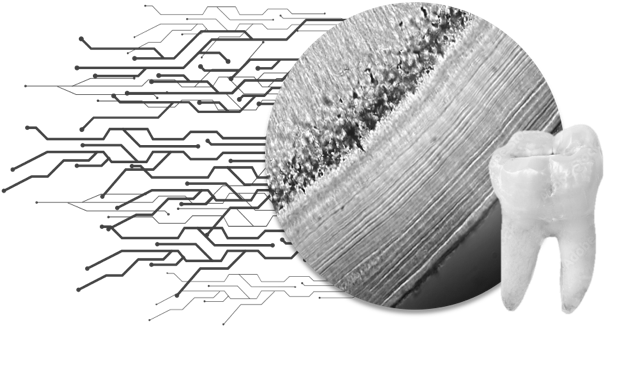


Principal Investigators
Carina Marques
Benoit Bertrand
David Navega
Senior personnel - Co-Investigator
Eugénia Cunha
Kate Spradley
Fred Prior

Forensic anthropologists traditionally rely on morphoscopic features of the human skeleton to estimate age-at-death. However, these methods have known limitations, including the poor correlation between skeletal degeneration and chronological age, producing broad age-at-death ranges. To overcome these limits, researchers have proposed the use of dental cementum (cementochronology) to estimate age-at-death accurately and precisely.
While cementochronology has shown promising results, the process of histological examination remains skill-based, subjective, and prone to intra-and inter- observer error, making standardization necessary to meet medico-legal requirements. Furthermore, the effect of individual and population variability (population affinity, pathological conditions), as well as the impact of environmental variables such as climate and latitude on the dental cementum deposits, consequently limiting cementochronology’s accuracy, has not been previously investigated. This project addresses this problem and aims to develop objective, quantitative, and user-friendly AI-based methods, that merge histological analysis and machine learning algorithms to significantly improve age-estimation in forensic sciences.
Studies in nonhuman mammals have shown that the season of death can also be estimated based on the outermost cementum deposit. This project will also investigate the applicability of dental cementum to estimate Fall-Winter/Spring-Summer season of death, which is a valuable parameter for forensic investigations.
On a large sample of 700 individuals, skeletal and dental cementum of the canine teeth will be analyzed through microscopic examination and individual and populational variables will be recorded. An original micrograph database will provide the basis for assessing cementochronology’s performance. Artificial intelligence modelling and machine learning algorithms will further refine age and season of death estimates. A website (www.cementochronology.com) and an AI-based web-application will be developed with a standardized, objective, and user-friendly age-at-death and season-of-death estimation method. This cost-free web-application will provide age-at-death estimations based on micrographs uploaded by forensic practitioners for their casework. This approach will eliminate errors and subjectivity of the micrograph’s interpretation. The website will also host a set of guidelines on how to integrate cementum analysis into forensic practice.
In conclusion, this project seeks to address the limitations of traditional age-at-death estimation methods by developing a standardized and objective method that merges histology and scientific computing. The project will improve age-at-death estimation accuracy and ensure applicability of cementochronology around the world and will have a great impact in the forensic community.